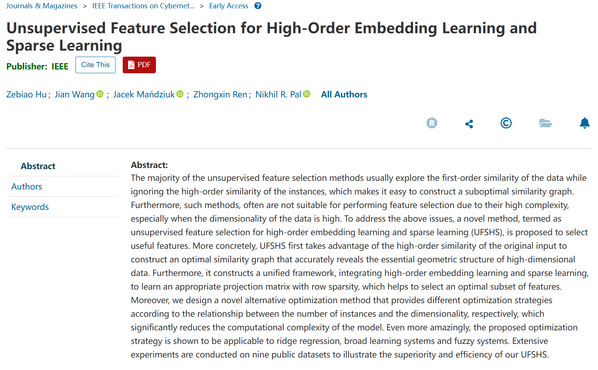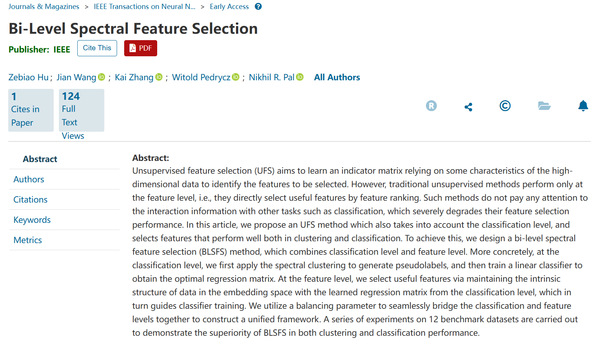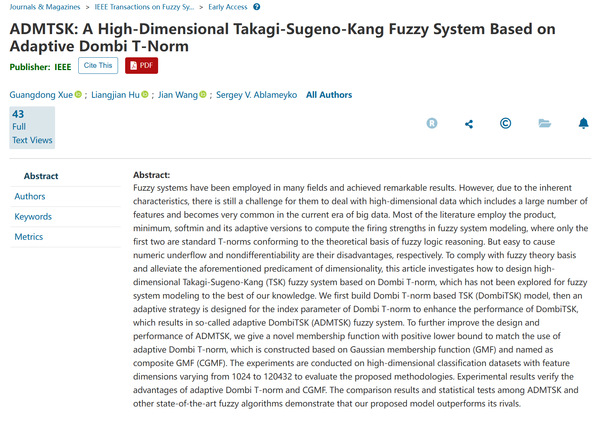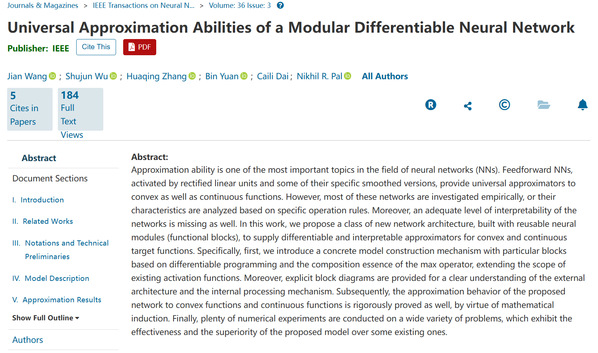Computational Intelligence is an important branch of Artificial Intelligence, emphasizing the use of biomimetic and approximate computational methods to solve complex problems, especially for non-linear uncertainty problems that are difficult to be solved by traditional mathematical modeling, which includes neural networks, fuzzy systems, and evolutionary computation. However, high-dimensional data are usually characterized by high dimensionality, data redundancy and noise, and traditional computational intelligence methods are limited by their own characteristics and are difficult to deal with high-dimensional data effectively. Therefore, exploring how to innovate the theory of computational intelligence to realize artificial intelligence models with low data dimensionality and high generalization ability is a topic of great research significance.
In view of this, the team constructed an unsupervised embedded feature selection model, a fuzzy system model with improved affiliation function, and an interpretable neural network model with reusable neural modules for high-dimensional data, which provide a theoretical basis for the application of computational intelligence in high-dimensional scenarios. The results have been published in IEEE Transactions on Neural Networks and Learning Systems, IEEE Transactions on Fuzzy Systems, and IEEE Transactions on Cybernetics. The above research work has been supported by the National Natural Science Foundation of China, the National Key Research and Development Program, the Fundamental Research Funds of the Central Universities, the China-Central and Eastern European Universities Joint Educational Program, the High-end Foreign Experts Introduction Program, and the “One Belt, One Road” Innovative Talent Exchange Foreign Experts Program.

Feature selection is a key step in computational intelligence and data mining, aiming to filter out the most relevant and useful features from raw data to improve model performance, reduce the risk of overfitting, and increase computational efficiency. The team proposes a feature selection model with higher-order embedding learning and sparse learning, which utilizes higher-order similarity learning to mine the intrinsic geometric structure of high-dimensional data, constructs the optimal similarity graph, and extracts the optimal low-dimensional representation of high-dimensional data through higher-order embedding learning. The sparse regression model is used to construct the optimal mapping matrix, thus realizing feature importance assessment. In addition, based on the relationship between the number of samples and features in the original data, a co-competition strategy is designed to optimize the mapping matrix, which significantly improves the computational efficiency of the model. The results are published in IEEE Transactions on Cybernetics under the title of “Unsupervised Feature Selection for High-Order Embedding Learning and Sparse Learning”. Cybernetics. The first author of the paper is Zebiao Hu, a PhD student of Class 2021, and the corresponding author is Prof. Jian Wang.

For high-dimensional data feature selection, the research team constructed a unified framework that fuses the data classification layer and feature layer.In the classification layer, pseudo-labels of data are generated based on discrete spectral clustering, and the optimal regression/mapping matrix is learned by training a linear regression model; in the feature layer, high-dimensional data are projected to a low-dimensional space based on the mapping matrix generated in the classification layer, and feature dimensionality reduction is achieved by introducing adaptive graph learning with row sparse regularization constraints.This work creatively constructs a spectral feature selection model for high-dimensional data from a new perspective, which extends the application scenario of unsupervised feature selection in computational intelligence.The results were published in IEEE Transactions on Neural Networks and Learning Systems under the title of “Bi-Level Spectral Feature Selection”.

High-dimensional data are becoming increasingly common in multiple domains, and fuzzy systems have difficulties in dealing with high-dimensional problems, among which the construction of fuzzy rule bases (FRBs) and the use of T-paradigms are the main hindering factors.The research team proposes a new fuzzy system modeling scheme applicable to high-dimensional data based on Dombi T-paradigm, designs an adaptive updating strategy for the indicated parameters in the Dombi T-paradigm, and proposes a composite Gaussian affiliation function for this strategy, and finally constructs a high-dimensional fuzzy system based on adaptive Dombi T-paradigm.Numerical experiments show that compared with similar methods, the recognition accuracy of this model is significantly improved on high-dimensional problems with tens of thousands of feature variables.The related results are published in IEEE Transactions on Fuzzy Systems under the title of “ADMTSK: A High-Dimensional Takagi-Sugeno-Kang Fuzzy System Based on Adaptive Dombi T-Norm”. Transactions on Fuzzy Systems. The first author of the paper is Guangdong Xue, a 2019 PhD student, and the corresponding author is Prof. Jian Wang.

Neural network is an important aspect of computational intelligence, and its approximation ability is of great significance in revealing its learning ability. Although activation functions such as ReLU are widely used, they suffer from problems such as non-differentiability and insufficient model interpretability. Based on the combinatorial properties of differentiable programming and max operator, the research team proposes a differentiable network model (MDN) constructed by reusable neural modules, extends the applicability range of ReLU and its smooth form activation functions, designs an explicit modularized architecture to enhance the interpretability of the network, rigorously proves the generalized approximation capability of this network for both convex and continuous functions, and then constructs a model of differential network (MDN) composed of two MDN modules, which is a model of the differential network (ReLU) and a model of the continuous network (ReLU).modules, and then construct a differential network model (DMDN) consisting of two MDN modules to enhance the expressive power.Numerical experiments show that the method has robust performance in handling high-dimensional data. The related results are published in IEEE Transactions on Neural Networks and Learning Systems under the title of “Universal Approximation Abilities of a Modular Differentiable Neural Network”. Networks and Learning Systems. The first author of the paper is Prof. Jian Wang, and the corresponding authors are Prof. Bin Yuan and Academician Nikhil R. Pal.
In recent years, Prof. Jian Wang's team has been devoted to solving the research work of computational intelligence in high-dimensional data processing, and formed the Joint Laboratory of Cross-Media Big Data (https://cilab.upc.edu.cn/) to make a series of advances in high-dimensional feature selection, high-dimensional fuzzy system design, and intelligent oil and gas field development, and made a series of advances in the fields of IEEE Transactions on Fuzzy Systems, IEEE Transactions on Systems, Man, and Cybernetics: Systems, IEEE Transactions on Neural Networks and Learning System, IEEE IEEE Transactions on Neural Networks and Learning System, IEEE Transactions on Evolutionary Computation and other international authoritative journals published more than 180 papers, cited more than 5,000 times, won the first prize of natural science of Shandong Artificial Intelligence Society, and undertook more than 10 sub-topics of the National Key Research and Development Program, National Natural Science Foundation of China, and PetroChina's major scientific and technological projects. The researchers have formed a certain international influence in the field of Computational Intelligence.